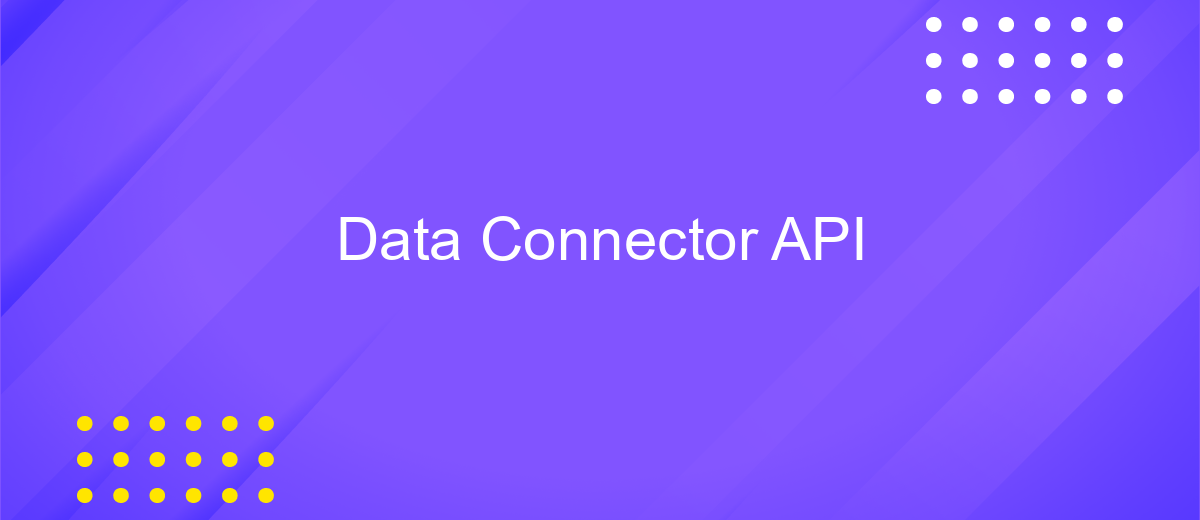Data Connector API
The Data Connector API serves as a vital bridge for seamless data integration between diverse systems and applications. By providing a unified interface, it simplifies the process of data exchange, enhancing efficiency and ensuring data consistency across platforms. Whether you're looking to synchronize databases, integrate cloud services, or automate workflows, the Data Connector API offers a robust solution to meet your integration needs.
Overview
The Data Connector API is a powerful tool designed to streamline data integration and management across various platforms. It provides a seamless interface for developers to connect, retrieve, and manipulate data from multiple sources, enhancing the efficiency and effectiveness of data-driven applications. With its robust capabilities, the API simplifies complex data workflows, enabling businesses to focus more on insights and decision-making rather than data handling.
- Easy integration with diverse data sources, including databases, cloud services, and third-party applications.
- Comprehensive documentation and support for developers to facilitate quick implementation.
- Advanced security features to ensure data privacy and protection.
- Scalable architecture to accommodate growing data needs and user demands.
- Real-time data synchronization to maintain up-to-date information across platforms.
By leveraging the Data Connector API, organizations can unlock the full potential of their data assets. It empowers teams to build dynamic, data-driven solutions that are both scalable and secure. As a result, businesses can achieve greater agility and responsiveness in today's fast-paced digital environment, driving innovation and competitive advantage.
Capabilities

The Data Connector API offers a robust suite of capabilities designed to streamline data integration and enhance operational efficiency. It enables seamless connectivity between disparate data sources, allowing businesses to effortlessly consolidate information for comprehensive analysis. With its flexible architecture, the API supports a wide range of data formats and protocols, ensuring compatibility with various systems and platforms. This versatility empowers organizations to customize their data workflows, facilitating real-time data synchronization and reducing manual intervention.
Moreover, the API's intuitive interface simplifies the process of setting up and managing integrations. Services like ApiX-Drive further enhance these capabilities by providing user-friendly tools to automate data transfers without requiring extensive technical expertise. ApiX-Drive's platform allows users to easily configure triggers and actions, ensuring that data is accurately and efficiently transferred between applications. This not only saves time but also minimizes the risk of errors, enabling businesses to maintain data integrity and focus on strategic initiatives. Together, the Data Connector API and ApiX-Drive offer a comprehensive solution for optimizing data-driven processes.
How-to guide

The Data Connector API allows seamless integration of various data sources into your application, enhancing its functionality and data accessibility. To effectively utilize this API, begin by understanding its core features and capabilities. Familiarize yourself with the API documentation to get an overview of the available endpoints and required authentication methods. This foundational knowledge will aid in successful implementation.
- Register your application to obtain the necessary API keys and tokens.
- Set up your development environment by installing any required libraries or SDKs.
- Use the API documentation to identify the endpoints relevant to your needs.
- Implement API calls in your application, ensuring proper error handling and data validation.
- Test the integration thoroughly to ensure data accuracy and reliability.
Once your integration is complete, monitor the API usage and performance regularly. This will help you identify any potential issues and optimize your application as needed. By following these steps, you can effectively leverage the Data Connector API to enhance your application's data capabilities and provide a richer user experience.
Best practices

When working with Data Connector API, it is crucial to ensure efficient data integration and seamless communication between systems. Start by thoroughly understanding the API documentation to grasp its capabilities and limitations. This foundational knowledge will guide your integration efforts and help avoid common pitfalls.
Security should be a top priority. Implement robust authentication and authorization mechanisms to protect sensitive data. Regularly update your security protocols to align with industry standards and protect against emerging threats. Monitoring and logging are also essential to quickly identify and resolve issues.
- Utilize pagination to handle large datasets efficiently and avoid overloading your system.
- Implement caching strategies to reduce redundant API requests and improve response times.
- Ensure data validation and error handling to maintain data integrity and improve user experience.
- Leverage rate limiting to prevent abuse and ensure fair usage of API resources.
Finally, maintain clear and comprehensive documentation for your integration. This will not only assist your team but also support future developers in understanding and extending the integration. Regularly review and update your practices to adapt to changes in the API and evolving business needs.


Frequently asked questions
What is Data Connector API? Data Connector API is a tool that allows applications to communicate and share data seamlessly. It acts as a bridge between different software systems, enabling them to work together efficiently. By using Data Connector API, businesses can integrate various platforms, automate workflows, and improve data accessibility without manual intervention.
How can I set up integrations using Data Connector API? Setting up integrations can be streamlined with services like ApiX-Drive. ApiX-Drive simplifies the process by providing a user-friendly platform that connects your apps without requiring extensive coding knowledge. You can easily configure triggers and actions between your applications, ensuring data flows smoothly across systems. This allows you to focus on your core business activities while ApiX-Drive handles the technical aspects of integration.
FAQ
What is a Data Connector API?
How can I integrate a Data Connector API into my workflow?
What are the benefits of using a Data Connector API?
Is it secure to use a Data Connector API for data exchange?
What should I consider before choosing a Data Connector API?
Apix-Drive is a simple and efficient system connector that will help you automate routine tasks and optimize business processes. You can save time and money, direct these resources to more important purposes. Test ApiX-Drive and make sure that this tool will relieve your employees and after 5 minutes of settings your business will start working faster.

